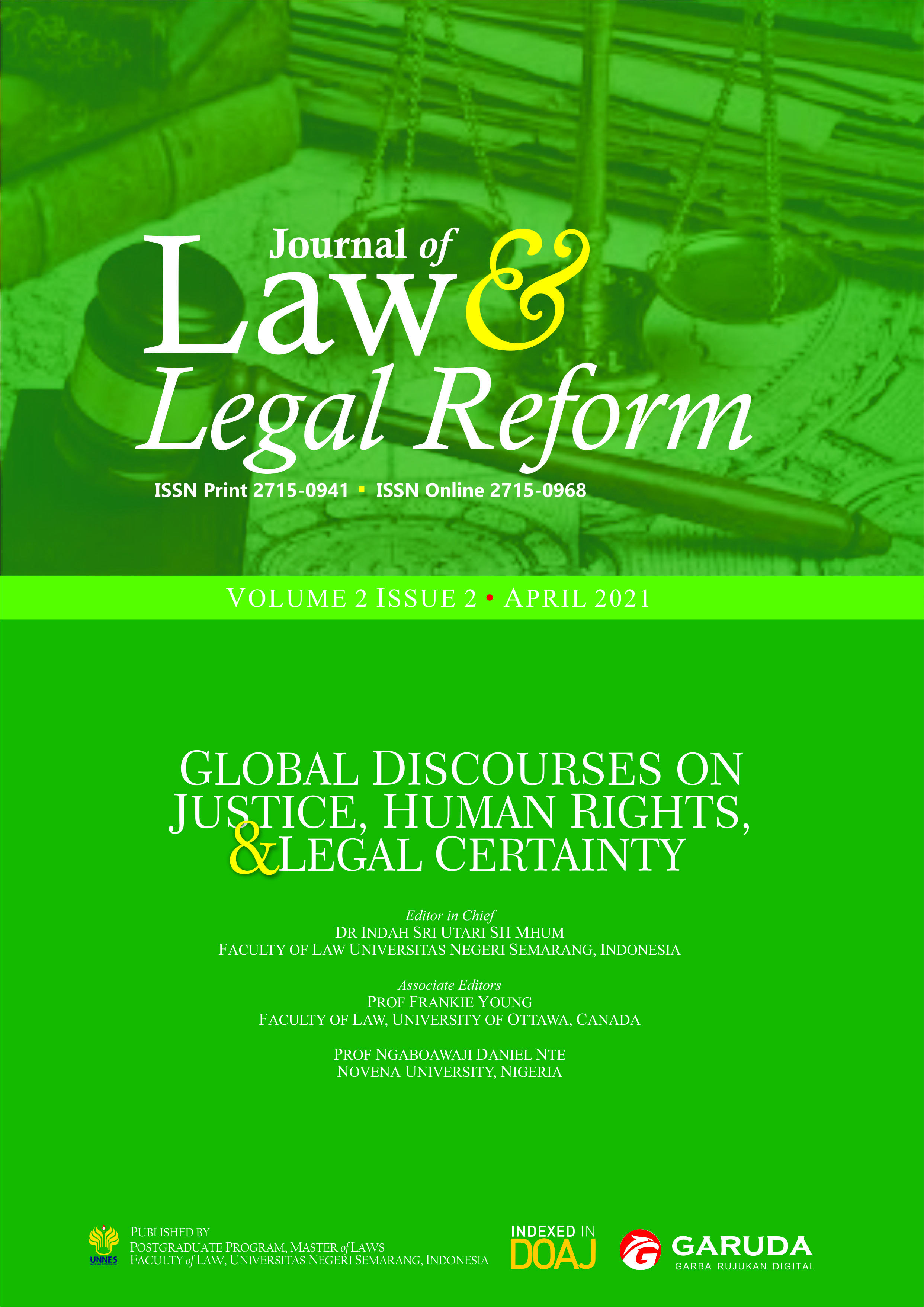Non-Penal Deradicalization of Former Terrorist Prisoners (Study at Lingkar Perdamaian Foundation)
Main Article Content
Abstract
After having been freed from correctional institutions, there were many former terrorism prisoners who got difficulties or challenges to find a job and interact with the society. This research aims to identifying and analyzing the radicalism reality of the former terrorism prisoners in Indonesia and deradicalization efforts conducted by Lingkar Perdamaian Foundation toward the former terrorism prisoners. This study used juridical-sociologic approach and applied qualitative research. The result of this research showed that the former terrorism prisoners gained enormous potential to redo their crime. Several factors that led them to be steadily radical were ineffective guidance attempts undertaken by correctional institutions, no suitable places to stay after they were freed from the correctional institutions and strong stigma possessed by society which caused the former terrorism prisoners to rejoin their previous radical community. The deradicalization efforts conducted by Lingkar Perdamaian Foundation were helping, empowering, training and boosting the former terrorism prisoners to be better people and serving new community for them in order that they would not rejoin their previous radical groups. The conclusion drawn from this research is that the reality of the former terrorism prisoners in Indonesia after they are freed from the correctional institutions is steadily radical. The deradicalization efforts done by Lingkar Perdamaian Foundation are serving trust, life autonomy, room for interaction and socialization with broader society in order that the former prisoners are kept away from negative stigma of former terrorists.
Article Details
All writings published in this journal are personal views of the authors and do not represent the views of this journal and the author's affiliated institutions. Author(s) retain copyrights under a Creative Commons Attribution-NonCommercial-ShareAlike 4.0 International (CC BY-NC-SA 4.0).
References
Andrie, T. (2011). Kehidupan di balik Jeruji: Terorisme dan Kehidupan Penjara di Indonesia. Institute for International Peace Building Position Paper, 2, 11-14.
Bakti, A. S. (2016). Deradikalisasi Nusantara (Perang Semesta Berbasis Kearifan Lokal Melawan Radikalisasi dan Terorisme. Jakarta: Daulat Press Kreatif.
Firdaus, I. (2017). Penempatan Narapidana Teroris di Lembaga Pemasyarakatan (Putting Convicted Terrorists in Correctional Institution). Jurnal Penelitian Hukum DE JURE, XVII(4), 429-443.
International Crisis Group. (2007). Deradicalisation and Indonesian Prisons. Asia Report No. 142, 19 November 2007.
IPAC Report. (2013). PRISON PROBLEMS: Planned and Unplanned Releases of Convicted Extremists in Indonesia 2 September 2013. Jakarta: Institute for Policy Analysis of Conflict (IPAC).
Ismail, N. H. (2010). Prison Radicalization and How It Happens: An Analysis into Root Causes of Terrorism. The Jakarta Post Online, retrieved from http://www.thejakartapost.com/news/2010/08/27/prison-radicalization-and-how-it-happens-an-analysis-root-causes-terrorism.html.
Maskur, M. A. (2017). “Deradikalisasi Pelaku Terorâ€. Online, from http://fh.unnes.ac.id/index.php/gagasan-pakar/deradikalisasi-pelaku-teror/.
Masyhar, A. (2008). Pergulatan Kebijakan Hukum Pidana dalam Ranah Tatanan Sosial. Semarang: Universitas Negeri Semarang Press.
Masyhar, A. (2009). Gaya Indonesia Memerangi Terorisme. Bandung: Mandar Maju.
Masyhar, A. (2016). “Memangkas Penularan Terorâ€. Online, retrieved from http://unnes.ac.id/pakar/memangkas-penularan-teror/.
Neumann, P.R. (2010). Prisons and Terrorism Radicalisation and De-radicalisation in 15 Countries. London: The International Centre for the Study of Radicalisation and Political Violence (ICSR).
Septian, F. (2012). Pelaksanaan Deradikalisasi Narapidana Terorisme di Lembaga Pemasyarakatan Kelas I Cipinang. Jurnal Kriminologi Indonesia, 7(1), 108-133.
